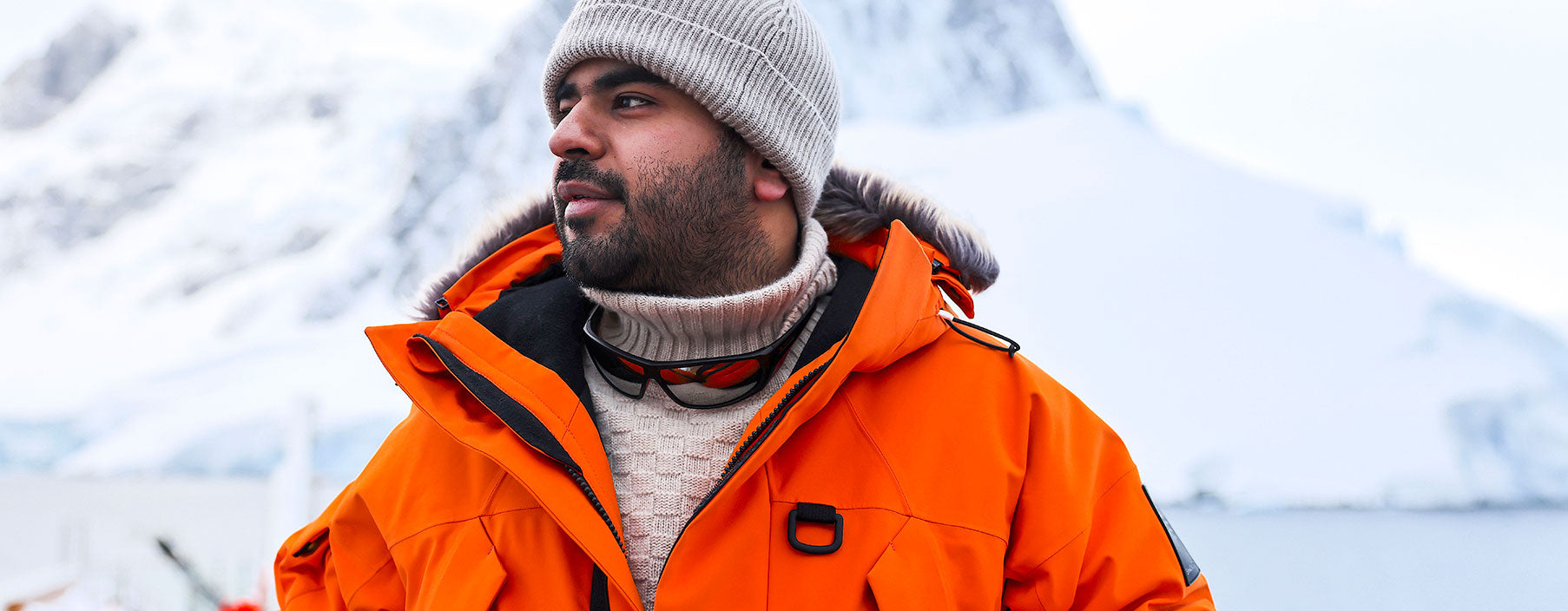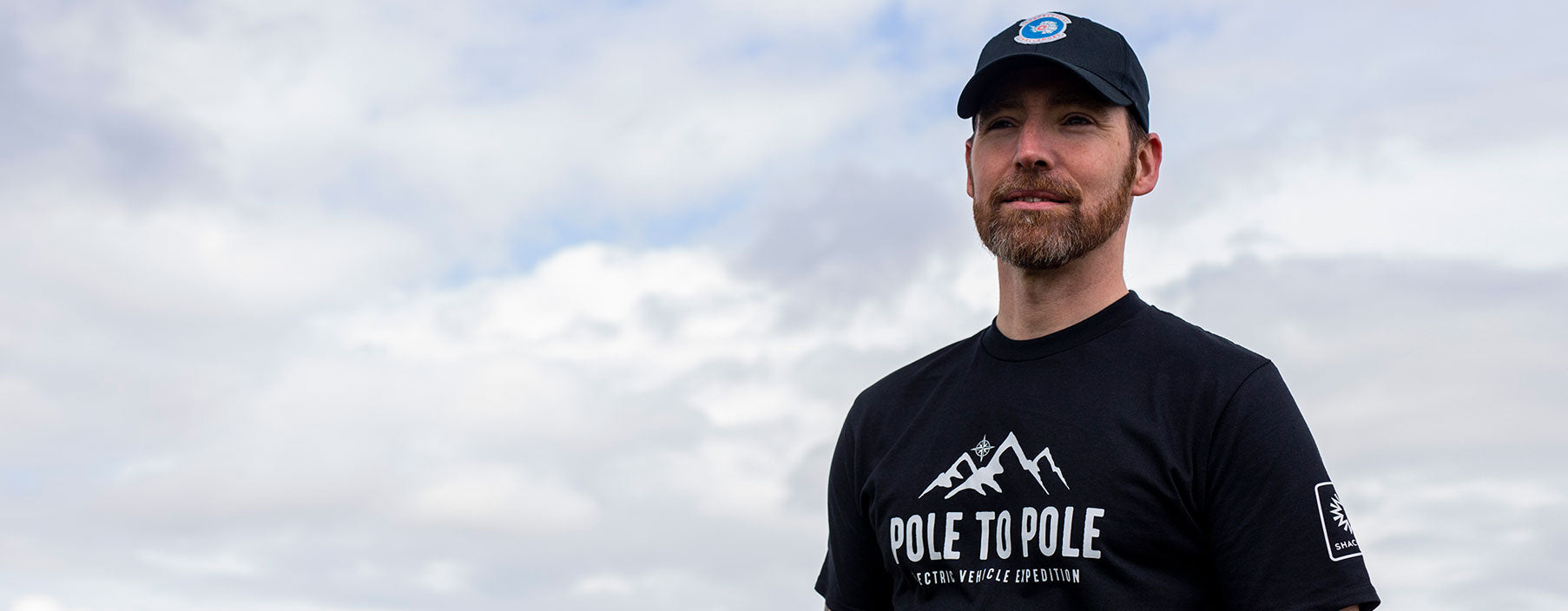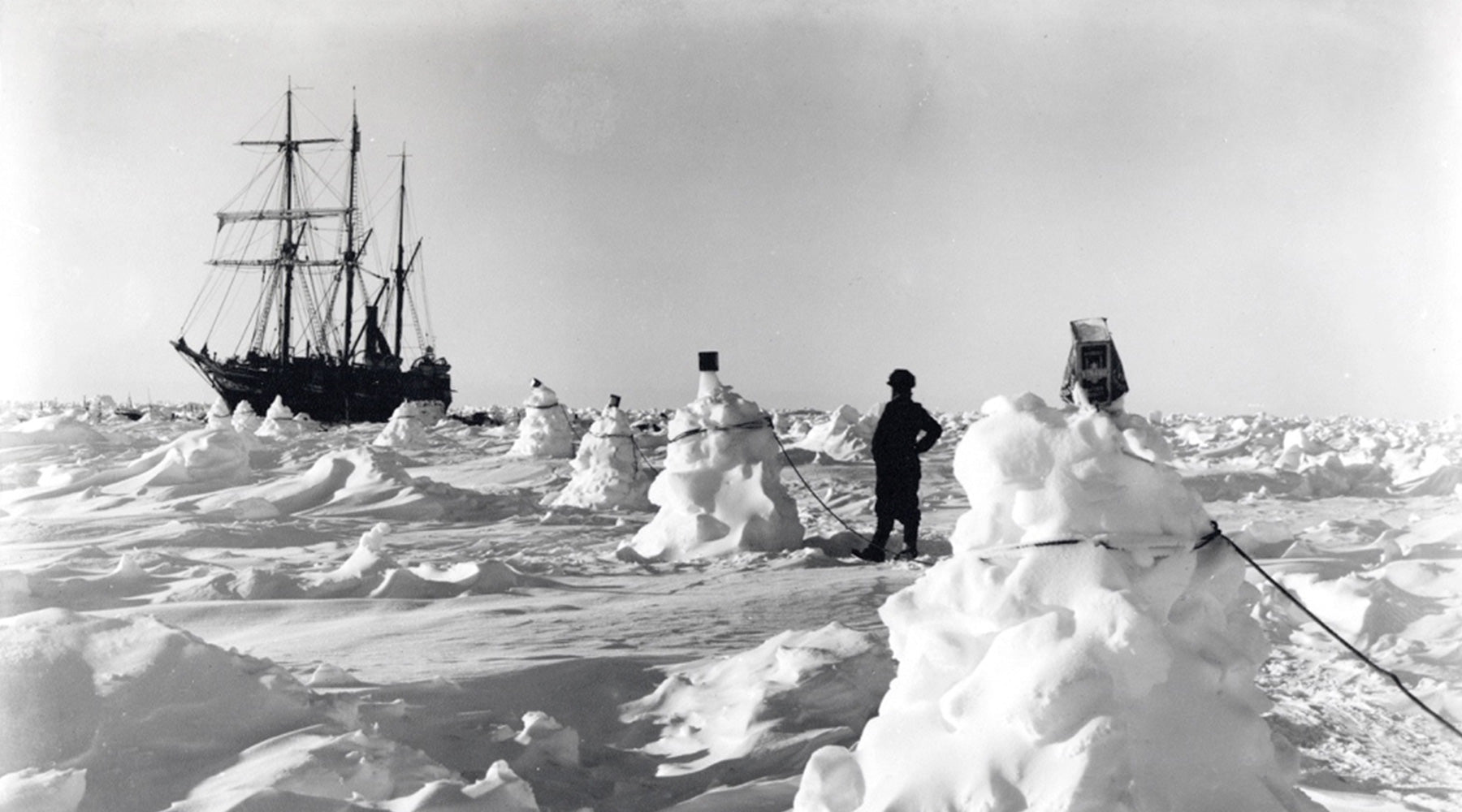
Notes from the 2041 Foundation ClimateForce: Antarctic Expedition
Shackleton Co-Founder Martin Brooks spoke to Agam Dhingra, a sustainability-focussed leader from India, who just returned from the 2041 Foundation ClimateForce: Antarctic Expedition.
The 2041 Foundation was founded by Robert Swan, OBE, the first person in history to walk to both the North and South Poles.
On the expedition Agam was fully protected by Shackleton expedition apparel.
So tell us what you’ve been doing, why have you been to Antarctica?
“I’ve been working on sustainability projects outside work since high school. I was selected for a climate change national workshop back in India in 2011, where I met Divya Nawale, a 2041 alumni, who had already been to Antarctica. More or less everything since then has been focused on getting myself to Antarctica. It has taken more than a decade but it has been a very exciting and fulfilling journey.
“I think last year felt like a good time to apply because the world was reeling from the pandemic and it gave me an opportunity to go on this amazing expedition with a bunch of stellar folks from different organisations with the legendary Robert Swan.”
Tell us more about how you got connected to Robert Swan and 2041?
“The alumni who I met, she actually sent an email to the expedition organisers, introducing me and that got the ball rolling. Finally after applying in January 2021, involving a long application process and interviews, I got the selection email in April.”
Did Covid pose any challenges to the expedition?
"It did - quite a few in fact! This particular expedition has been 3 years in the making because it kept getting postponed due to Covid. Fundraising to go on the expedition was also a strenuous process - how do you approach potential sponsors in the middle of a pandemic and a health crisis at its height? I faced numerous challenges in getting a visa too with the Argentina embassy in New Delhi closed in January due to lockdown and then a Covid case at the Consulate. Plus, with British Airways being one of my other supporters, I had to transit via London and getting a UK visa was an ordeal in itself due to the huge backlog - again because of travel restrictions as a result of Covid.
“Nonetheless, stringent testing both pre and during the expedition, and social distancing measures, allowed us successfully complete the expedition without a single case of Covid. It is historic in a way especially since all expeditions to Antarctica have had at least one case of Covid after the expeditions resumed this season.”
Tell us all about 2041 then, what’s it all about?
“The 2041 Foundation was founded by Sir Robert Swan who has dedicated his life to the preservation of Antarctica through the promotion of recycling, renewable energy and sustainability to combat the effects of climate change. The Foundation gets its name from the year in which the Antarctic Treaty System is up for renegotiation, when countries could try to claim a piece of Antarctica for exploration, drilling and poaching of wildlife et cetera. Robert Swan has been working to raise awareness and ensure that the treaty, once it is up for renegotiation, is re-ratified.”
He was really inspired by Jacques Cousteau, wasn’t he?
“Yes, Jacques Cousteau gave Robert Swan a 50-year mission to save Antarctica from the realities of climate change. Jacques urged Robert to engage young people and promote the use of renewable energy. Since then, Robert founded the 2041 Foundation and dedicated his life to the preservation of Antarctica through the promotion of sustainability practices.
“There’s also, of course, Sir Ernest Shackleton.
“Over the years Robert Swan has been to both Antarctica and the North Pole, and his journey to both the poles and visiting different countries and meeting people from diverse cultures has inspired him to work on this collective ‘good’.”
He is amazing, so what’s his strategy for bringing everyone’s focus to 2041? It’s basically getting a load of influential people to Antarctica isn’t it?
“Yes, especially with the expedition, he gets young change-makers and leaders to come to Antarctica and see for themselves the impact of climate change unfolding in real-time in the frozen continent, so they head back home inspired and amplify the message. Robert often says, “The greatest threat to our planet is the belief that someone else will save it”. Personally speaking, having been to Antarctica, all I can say is that once you see what is actually happening and how it’s taking its toll on the environment and the wider world - when you actually go and see glaciers melting, icebergs floating around… we went to the iceberg graveyard - as much as it is stunning to see, it is also heartbreaking - and it dawns upon you that there’s no time to sit back and relax in the fight against climate change.
“We went to Paradise Bay for instance, and Rob mentioned o how much the ice cover has receded from his early years of having visited Antarctica.”
What are some of the strongest memories that are forever in your heart and in your head now?
"On one of the days it was raining the entire day and that's something that is unprecedented - it typically rains for an hour or so - that was also around the same time that the Conger ice shelf, as big as Rome broke off in East Antarctica and Concordia Research Station recorded temperatures 38 degrees above the average. So that was a stark reminder of what’s actually happening and I got to witness it.
“Secondly, the day we got to Antarctica we saw the most stunning sunsets I think I’ll ever see in my life. Even the ship captain came out to take photos.
“And the first time I saw penguins and humpback whales. We saw a lot of Gentoo Penguins, so that’s something I’ll never forget.
“It’s also very interesting because this was the first time I saw ice and snow. I was trying to do a recording imitating Armstrong’s first steps on the moon: ‘One small step for man, one giant leap for mankind’ jumping onto the Antarctic landscape.” (laughs)
Which other places were on your itinerary, did you go to Deception Island?
“We also went to Deception Island, and Rob spoke about the whaling industry over there.”
I hated that place, it’s awful. There’s a smell of misery there, and knowing there are forty thousand whale carcasses at the bottom of that caldera. I saw the pictures next to the big blubber barrels, and I just felt heavy. There’s also picture of you climbing back up Neptune’s Bellows - I’ve got a picture of me in exactly the same spot.
“What a wonderfully amazing coincidence to have the same photo…
“Deception Island is huge from one edge to another, it’s a pretty long distance. I spoke with Rob where all the storage bins were located and I walked up to Neptune’s Window. The landscape is stunning because it changes from all icy, and white, to essentially an active volcano.
“An interesting takeaway for me was, Rob spoke about how, when electricity was invented, the whaling industry basically stopped. And right now, after the pandemic, and the fact that there’s an energy crisis the world over, this might actually be a tipping point and a moment of awakening for all of humanity to switch to alternative and greener energy sources at a much accelerated rate.
“Gazprom shut off gas to Bulgaria and Poland yesterday… it’s insane as to what’s happening. Europe as a whole is trying to move more towards renewable sources of energy.”
Tell me about some of the other individuals that were on the expedition.
“We had the Director of the Ellen Fund, Casey Rogers. Founded by Ellen DeGeneres, the Fund supports global conservation efforts for endangered species the world over, especially with gorillas in Africa. She spoke about her journey and what has inspired her personally, her association with The Ellen fund, and the work that she’s doing.
“We also had the Chief Climate Change Adviser at Shell, David Hone, who was in a very tricky spot – working for one of the largest oil and energy companies in the world… and here he was talking about climate change to a group of 100+ climate change and sustainability advocates…but we learnt a lot from him about the energy transition currently taking place.”
That’s a difficult job. You’ve got to be a pretty robust person to take that job.
“Yes, indeed!
“HP’s Global Head of Social Impact, Michele Malejki, walked us through the amazing work HP is doing in Haiti with ocean-bound plastics – basically reinventing the wheel to recycle and reuse what would eventually end up in the ocean – and giving income opportunities to the locals over there along the way.

Agam with Michele Malejki, Global Head of social Impact at HP.
Then there was Gez Draycott, VP of Solutions Engineering at SES Networks who was leading and managing all the live sessions that Rob was doing from Antarctica for schools across the UK.
“We also had Erika Yorio who is the Director of Memberships at Helena, a US-based global problem-solving organisation. She found me on the expedition because somebody told her that I am being supported by Shackleton, the clothing brand. She shared the story of her artist friend – Cat Glennon, who makes work about Antarctica and has the coordinates to Antarctica from Shackleton’s Endurance expedition tattooed on her arm.

Cat Glennon and her 'Endurance' Expedition tattoo.
“Another inspiring person who had joined the expedition was Dej Knuckey who is the co-founder of an energy storage company but was on the expedition exploring Antarctica through her dad’s journals from his own Antarctic expedition in 1958-59 - how inspiring is that!
“From India we had a contingent of 31 people, given the population I think it was also fair for us to have the largest representation (laughs). We had folks working for the UN, a couple of them working with the Indian government in administrative services and helping implement policy at the grassroots level.
“On the ship, the main lecture room was called Shackleton, so wherever I went, the Boss followed me in spirit.”
Shortly we will be launching our Last Degree challenge, giving people the chance to walk the last 60 nautical miles from 89˚S to 90˚S, Robert Swan has a similar expedition coming up.
“Yes, Robert Swan is going to attempt the same, for the third time as on his last attempt his hip blew out, coincidentally at the same point that Shackleton turned back. Physically he appears very fit but I believe with the hip issues, he relies on hiking sticks.”
That’s pretty brave to be doing the last degree if he’s usually walking with sticks and pulling a pulk.
“Absolutely, right now I think he’s doing a lot of workshops and public speaking.”
And Barney, his son, what’s he like?
“Both Robert and Barney are very down to earth and humble. Barney founded ClimateForce to make sustainability more accessible. He is currently working on a forest regeneration project in Australia which is planting 300,000+ native Australian trees in the world’s oldest rainforest, Daintree. What inspired him to start ClimateForce was that a lot of alumni that used to come back from the 2041 Antarctic Expedition were very confused and dazed as to what to do. He’s trying to bridge that gap between what you learn, what you see and how you can implement all of it in your life once you are back home and give back to your communities.”
So are you heading back to Delhi, straight back to work?
“I’m heading back to Delhi on Monday with a lot of amazing memories and having met a bunch of exciting people. I’m still processing, because I’m still in two minds as to what I’m going to do, how am I going to channel what I learnt. I’m going straight back to work, but I’m going to look at ways to integrate my learnings into helping my clients become more sustainable.”
Finally, I’ve obviously got to ask you - did you stay warm enough?
"If it weren’t for the Shackleton parka, layers and sweater I would have probably frozen to death because I’ve never been to such a cold climate. I'm used to 40 degrees - it was the first time I saw snow and ice!
"What was also exciting, was that the parka was orange, so everybody could spot me from afar - I stood out which was great."


